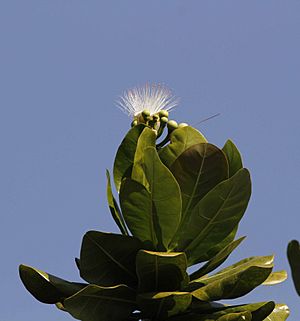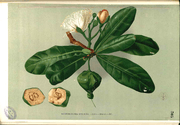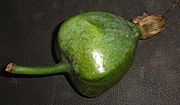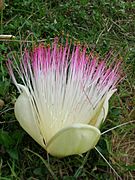Fish poison tree facts for kids
Quick facts for kids Fish poison tree |
|
|---|---|
 |
|
| Flower and leaf, Bangladesh | |
| Conservation status | |
| Scientific classification | |
| Synonyms | |
|
The Barringtonia asiatica is a cool tree often called the fish poison tree or sea poison tree. It grows in warm places like islands in the Indian Ocean and parts of tropical Asia and the western Pacific Ocean. You might see it planted along streets in some towns because it's pretty and gives good shade. It's also known as the Box Fruit tree because its fruit looks like a box! The name futu for the Polynesian island Futuna even comes from this tree. A famous scientist named Carl Linnaeus first described this tree in 1753.
What Does It Look Like?
This tree can grow quite tall, usually between 7 and 25 meters (about 23 to 82 feet). Its leaves are large, shaped like a narrow oval. They can be 20–40 cm long and 10–20 cm wide. The fruit is super unique! It's called the Box Fruit because it has distinct square-like edges. It's about 9–11 cm wide and has a thick, spongy layer that protects a seed inside.
How Does It Spread?
The Box Fruit tree has a clever way of spreading its seeds. Just like a coconut, its fruit can float in the ocean. It's super good at resisting water and can stay afloat for up to fifteen years! This is why it was one of the first plants to grow on Anak Krakatau. This island appeared after the huge Krakatau volcano eruption. When the fruit washes ashore and gets wet from rainwater, the seeds inside start to grow.
How People Use It
All parts of the fish poison tree have natural substances that can stun or affect living things. The Box Fruit is strong enough to be used to help catch fish. People traditionally grind the seeds into a powder. This powder is then used to stun or kill fish, making them easier to catch. The good news is that the fish's meat is still safe to eat.
Gallery
-
Illustration from Flora de Filipinas by Francisco Manuel Blanco





